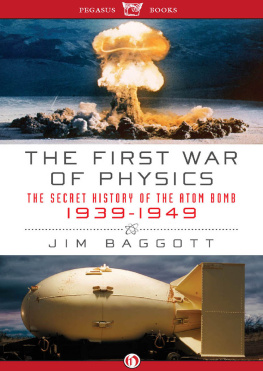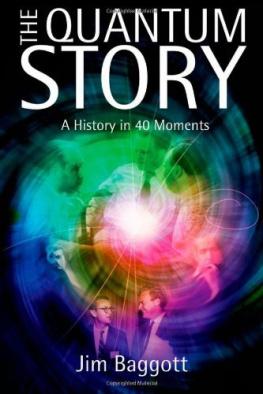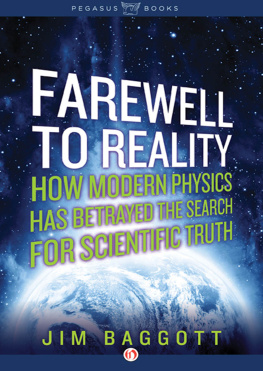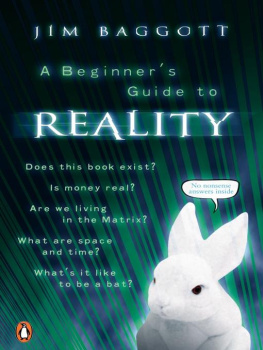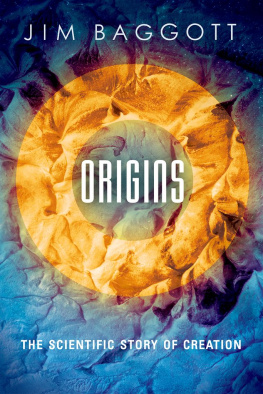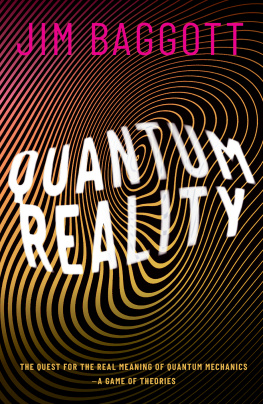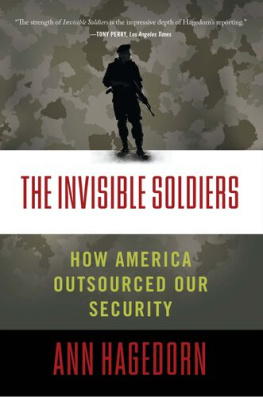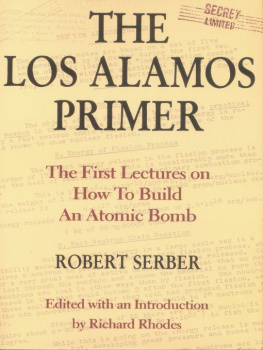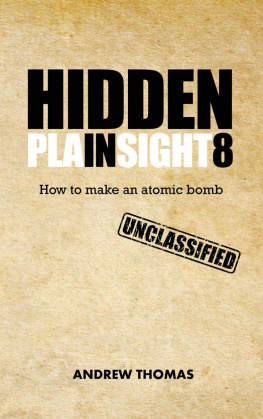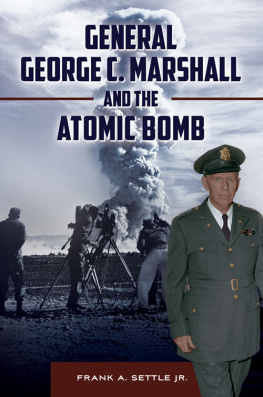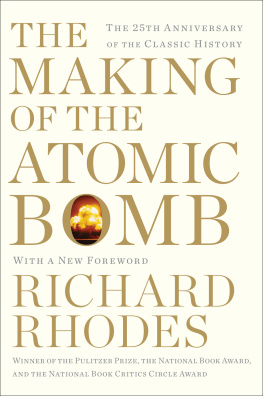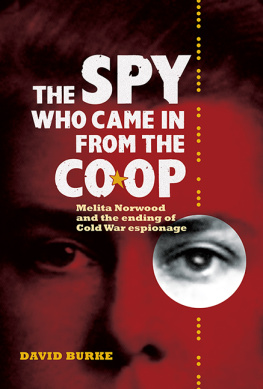


PEGASUS BOOKS
NEW YORK
For Jini,
My soulmate
CONTENTS
LIST OF ILLUSTRATIONS
About the author
Jim Baggott is an award-winning science writer. A former academic scientist, he now works as an independent business consultant but maintains a broad interest in science, philosophy and history, and continues to write on these subjects in his spare time. His previous books have been widely acclaimed and include A Beginners Guide to Reality (Penguin, 2005), Beyond Measure: Modern Physics, Philosophy and the Meaning of Quantum Theory (Oxford University Press, 2004) and Perfect Symmetry: The Accidental Discovery of Buckminsterfullerene (Oxford University Press, 1994).
PREFACE
F rom the very moment of their conception, atomic weapons have been synonymous with fear. Fear that Hitlers Nazi Germany might be first to build an atomic bomb drove Anglo-American efforts during the Second World War. Fear that America might threaten a first nuclear strike drove the Soviet Unions own bomb programme during the Cold War that followed.
I was born in 1957, and grew up in the shadow of the fear inspired by Cold War rhetoric and the concept of mutual assured destruction. I was just five years old when, during the Cuban missile crisis in October 1962, the US Strategic Air Command carried aloft thermonuclear weapons with a total explosive potential of more than half a million Hiroshimas. As Air Force chief of staff Curtis LeMay urged President John F. Kennedy to hit the Soviet Union with everything in the US nuclear arsenal, the world held its breath.
Just how did this happen? How did this dreadful instrument of fear come to be created? Of course, the bomb was created by some of the worlds greatest physicists, many of them Nobel laureates physicists who, only a few years before, had been leading a series of revolutions in theoretical science and shaking the very foundations of our understanding of physical reality. But how did these men become such profoundly important military resources in a war that was to redefine the very meaning of barbarity, a war that was to recalibrate what it means to be inhuman? How did these other-worldly eggheads find themselves centre-stage in such a drama of heroic endeavour, sabotage, espionage, counter-espionage, assassination and terrible destruction that it now seems barely credible as fiction? How did they come, in the words of J. Robert Oppenheimer, to know sin?
These were men such as Niels Bohr, Albert Einstein, Enrico Fermi, Richard Feynman, Otto Frisch, Klaus Fuchs, Werner Heisenberg, Yuli Khariton, Igor Kurchatov, Oppenheimer, Edward Teller, and many, many more. Diverted from their academic preoccupations by the biggest military conflict in human history, they became deeply embroiled in the biggest of human dramas. They found themselves drawn inexorably into a project to build the worlds most awful weapon of war, a weapon judged to be practically irresistible at a time when the world was threatened by the darkest evil.
Confronted with bare historical facts, our questions tumble out. The devastation that could be wrought with atomic weapons was obvious to the physicists right from the start, so why did they persist in developing these weapons, without hesitation? Why, despite having a clear lead in nuclear physics at the beginning of the Second World War, did German physicists fail to develop an atomic bomb? Did the Allies really plot to have Heisenberg kidnapped or assassinated? Why, when it became clear that there was no threat of a Nazi weapon, did the Allies use the atomic bomb, without warning, against Japan? To what extent did the Soviet atomic programme rely on intelligence gathered by spies such as Klaus Fuchs, Theodore Hall, David Greenglass and the Rosenbergs? Could the Soviets have developed the bomb without them? What was the full extent of Soviet penetration of the Manhattan Project?
Were the physicists merely instruments in a political game-plan to establish supremacy in a post-war world? Or did they knowingly inspire the arms race? What, if any, lessons can be drawn from this history to inform our perspective on nuclear energy and the proliferation of weapons technology today?
This book is my attempt to answer these and many other questions through a popular, accessible account of the race to build the first atomic bombs, centred on the individual stories of the physicists directly involved. The book spans ten historic years, beginning with the discovery of nuclear fission in early 1939 and closing shortly after Joe-1, the first Soviet atomic bomb test in August 1949.
Now, parts of this story have already been told, and told very well. But there are important strands of the story that have emerged only within the last decade or so, relating specifically to aspects of the German and Soviet atomic programmes and penetration of the Manhattan Project by Soviet spies. These new materials allow a single-volume popular history of the Anglo-American, German and Soviet programmes to be assembled for the first time.
The book is organised in four parts. Part I covers the mobilisation of nuclear physicists around the world following the outbreak of war in September 1939 and early work on atom bomb and reactor physics. Part II recounts the early frustrations and progress in weapon design, the development of bomb and reactor materials in Germany, Britain and America, the spectacular sabotage of the heavy water plant at Vemork by Norwegian commandos, and the establishment of the Soviet espionage operation codenamed ENORMOZ.
In Part III the book addresses the direct involvement of Allied scientists in the hunt for their German counterparts in war-torn Europe following the D-Day landings, the successful Trinity test at Alamogordo in New Mexico, the bombing of Hiroshima and Nagasaki, and the reactions of the captured German scientists on hearing of the Allied success.
Finally, Part IV describes the origins of the Cold War, the acceleration of the Soviet atomic programme, proliferation of weapons technology, the Venona project, the unmasking of Soviet spies, and the first successful Soviet test in August 1949. The book concludes with an extended epilogue which attempts to tie up many of the loose ends, describing the American and Soviet H-bomb programmes and the Cuban missile crisis which brought the world to the very edge of disaster.
For me, this book represents the end of a long journey. I suppose I can trace its beginning all the way back to my first classes in quantum mechanics, as an undergraduate student in Manchester, England, during the cold, damp winter of 197576. I probably didnt fully realise it back then, but I was completely captivated. To anyone tutored in the language and the logic of classical physics, quantum mechanics is at once mathematically challenging, maddeningly bizarre and breathtakingly beautiful. I have spent a lifetime trying to understand it.
The physicists who forged this outrageous new theory left their fingerprints all over it, in the form of new laws, physical constants, principles and approximations. It is impossible to study quantum mechanics without tripping over their names. To study quantum mechanics, therefore, is to study the physicists who made it. Many of these same physicists also played crucial roles in the development of the worlds first atomic bombs, and this juxtaposition has always fascinated me. To understand them is to understand the various roles they played in this development: the things that drove them, and the things that scared them.

